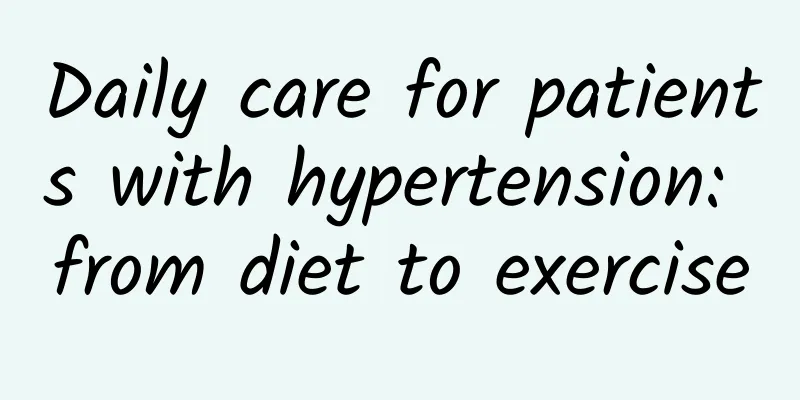Daily care for patients with hypertension: from diet to exercise

|
Hypertension, as a common chronic disease, has become one of the major public health issues worldwide. Hypertension is not only a disease that requires long-term management, but it can also cause many serious complications, such as heart disease, stroke, and kidney failure. Therefore, how to effectively manage hypertension in daily life is a topic that every patient and their family members need to pay attention to. This article will discuss in detail the daily care measures for patients with hypertension from two aspects: diet and exercise, in order to provide scientific and systematic guidance for the majority of patients. 1. Diet management Diet management is one of the core links in the daily care of patients with hypertension. Reasonable dietary structure and habits can not only help control blood pressure, but also prevent the occurrence of other chronic diseases. A high-salt diet is one of the important factors leading to hypertension. Excessive salt intake will increase the sodium content in the body, leading to increased blood volume, which in turn increases blood pressure. Therefore, patients with hypertension should strictly control their salt intake. The World Health Organization recommends that daily salt intake should be controlled below 5 grams. In actual operation, you can reduce your dependence on salt by reducing the use of salt and increasing the use of spices and natural ingredients for seasoning. In addition to controlling salt intake, patients with hypertension should also consume more fruits and vegetables. Fruits and vegetables are rich in potassium, magnesium and dietary fiber, all of which help lower blood pressure. Potassium can offset the blood pressure-raising effect of sodium, magnesium helps blood vessels dilate, and dietary fiber can improve intestinal health and promote metabolic balance. Patients with hypertension should consume at least 400 grams of vegetables and fruits every day, and the types should be as diverse as possible to ensure comprehensive nutrient intake. Patients with hypertension should choose low-fat foods, especially reduce the intake of saturated fat and trans fat. These fats increase the risk of arteriosclerosis, thereby raising blood pressure. Foods rich in high-quality protein such as fish, beans, nuts and lean meat should be selected. The omega-3 fatty acids in fish not only help lower blood pressure, but also improve cardiovascular health. In addition, a diet high in sugar and refined carbohydrates can lead to obesity and insulin resistance, which indirectly raises blood pressure. Patients with hypertension should minimize the intake of sweets, sugary drinks and refined pasta, and choose whole grains such as whole wheat bread, oats and brown rice. These foods not only provide a longer feeling of fullness, but also stabilize blood sugar levels. 2. Sports Management Exercise is another important part of daily care for people with hypertension. Regular physical exercise can not only help lower blood pressure, but it can also improve cardiopulmonary function and enhance the body's overall health. Aerobic exercise is the most recommended form of exercise for people with hypertension. Aerobic exercise includes brisk walking, jogging, cycling, and swimming. These exercises help improve heart and lung function and reduce the risk of heart disease. People with hypertension should do at least 150 minutes of moderate-intensity aerobic exercise per week, or 75 minutes of vigorous-intensity aerobic exercise per week. These exercises can be divided into multiple sessions, each lasting at least 10 minutes. Strength training is also an effective exercise for patients with hypertension. By increasing muscle strength and endurance, strength training can improve basal metabolic rate, help control weight, and thus indirectly help lower blood pressure. Strength training should be performed two to three times a week, and the focus of each training should be on large muscle groups, such as leg, back, and chest muscles. Patients should perform the exercise under the guidance of professionals to ensure the correctness and safety of the movements. Flexibility and balance exercises such as yoga, tai chi and stretching exercises are also beneficial for people with high blood pressure. These exercises not only improve the body's flexibility and coordination, but also help reduce stress and anxiety, which indirectly helps control blood pressure. People with high blood pressure should perform an appropriate amount of flexibility and balance exercises every day. Each exercise should not be too long, but should be persistent. When exercising, patients with hypertension should pay attention to the following points: First, choose the appropriate intensity and type of exercise according to their physical condition and avoid excessive exercise. Second, they should warm up properly before exercise and relax and stretch after exercise to prevent muscle strain and other sports injuries. Finally, they should pay attention to their body reactions at any time during exercise. If they experience discomfort such as dizziness or chest pain, they should stop exercising immediately and seek medical help. 3. Other adjustments to your lifestyle Smoking damages blood vessel health and increases the risk of arteriosclerosis, which in turn raises blood pressure. Hypertensive patients should quit smoking to reduce the risk of cardiovascular disease. Quitting smoking can not only significantly improve blood pressure levels, but also enhance lung function and reduce the risk of cancer. The process of quitting smoking may take a certain amount of time and perseverance. If necessary, you can seek professional guidance and support for quitting smoking. Long-term mental stress can lead to high blood pressure. Therefore, patients with hypertension should learn to manage stress and maintain psychological balance. Stress can be reduced through relaxation training, meditation, deep breathing and other methods. In addition, a reasonable arrangement of work and life and avoiding overwork are also important means of reducing stress. Hypertensive patients should monitor their blood pressure regularly to understand their blood pressure control status. Home blood pressure monitoring can help patients detect blood pressure fluctuations in a timely manner and take appropriate measures to adjust them. Patients should learn the correct blood pressure measurement method, record the results of each measurement, and report to their doctors regularly so that doctors can adjust treatment plans according to the situation. For patients with hypertension who need medication, they should take medication strictly according to the doctor's prescription and should not stop taking medication or change the dosage at will. Medication is an important means of controlling blood pressure. Only under the guidance of a doctor can the best efficacy and minimal side effects of the drug be ensured. 4. Family and Social Support The management of hypertension requires not only the efforts of the patient himself, but also the support of the family and society. Family members should understand the relevant knowledge of hypertension and support the patient's healthy behaviors, such as proper diet, regular exercise and taking medicine on time. The society should provide more health education and support services, such as hypertension prevention and treatment lectures, community sports facilities, etc., to create a good living environment for patients. The understanding and support of family members is an important motivation for hypertensive patients to adhere to healthy behaviors. Family members can help patients develop and implement diet and exercise plans, supervise patients to take medication on time, and provide psychological support when patients are depressed. Participating in healthy activities together, such as taking a family walk or cooking together, can not only strengthen the relationship between family members, but also improve their health together. Social support is equally important for the management of patients with hypertension. Community medical service agencies should provide services such as hypertension screening, health education and management guidance to help patients understand the disease and master management skills. The government and non-profit organizations should carry out hypertension prevention and treatment publicity activities to raise public awareness of hypertension and promote a healthy lifestyle. Summarize Hypertension is a chronic disease that requires long-term management, and daily care plays a vital role in the control and prevention of hypertension. From diet to exercise, from lifestyle adjustments to family and social support, every link has an important impact on blood pressure management. Through a scientific and reasonable diet structure, regular physical exercise, maintaining a healthy lifestyle, regular monitoring of blood pressure, and with the support of family and society, hypertensive patients can effectively control blood pressure, prevent complications, and improve their quality of life. The management of hypertension is a long-term task that requires the joint efforts of patients, families, and society. Only in this way can comprehensive health management be achieved and a better life be ushered in. Author: He Jingjing, Beijing Chaoyang Hospital, Capital Medical University |
<<: Children's Health Alert: Uncovering the early signs and diagnosis of medulloblastoma
>>: Beware of "insect bite dermatitis" in summer
Recommend
Causes of right lower abdominal pain
Right lower abdominal pain refers to pain in the ...
Can a vulvar tear heal on its own?
It is very common for women to have vulvar tears ...
Does the enlargement of a mole mean that it is becoming malignant?
Not necessarily Don't be afraid, the change i...
What causes dandruff after pregnancy?
In the early stages of pregnancy, many women will...
Things to note after having sex if you want to conceive
For couples who are preparing for pregnancy, they...
What causes abdominal pain in late pregnancy?
Many women are very cautious throughout their pre...
Can I use breast enhancement cream while breastfeeding?
If breast enhancement cream makes breasts larger ...
Why is the placenta accreta in the first pregnancy?
Embryo adhesion means that the placenta is not co...
How to treat vaginitis?
Women are always troubled by some gynecological d...
How is systemic lupus erythematosus treated? Can female patients still get pregnant and have children?
Author: Wu Donghai, Chief Physician of China-Japa...
What happens on the first day of medical abortion?
This is aimed at women. As today's society ha...
Experts: Parents should pay attention to the six signs of myopia in children and create a good visual environment
Children will habitually "squint" when ...
How to remove postpartum melasma
Chloasma is a very common skin disease. There are...









